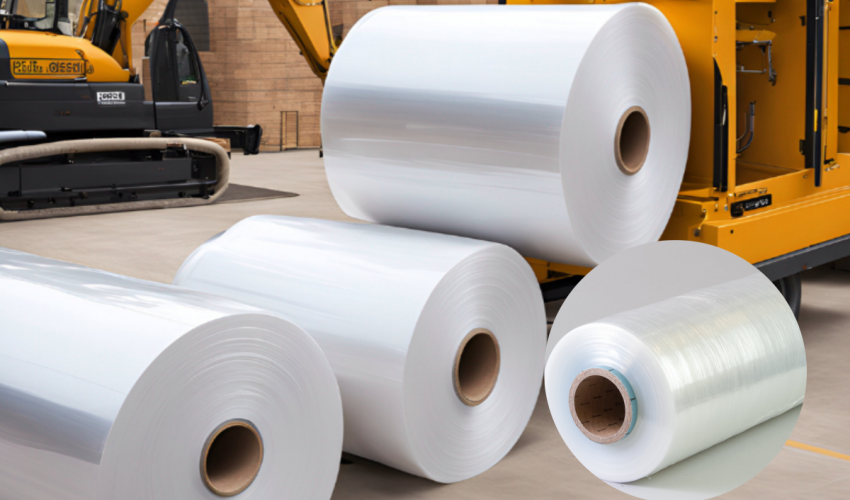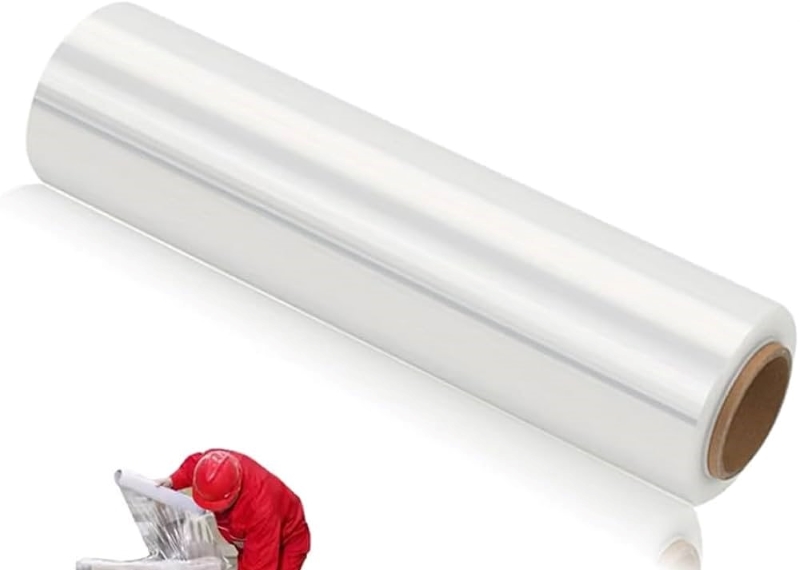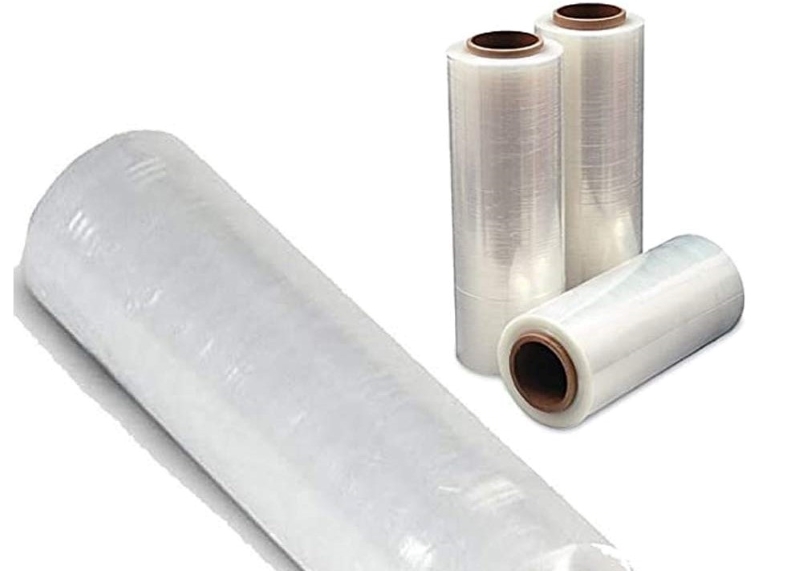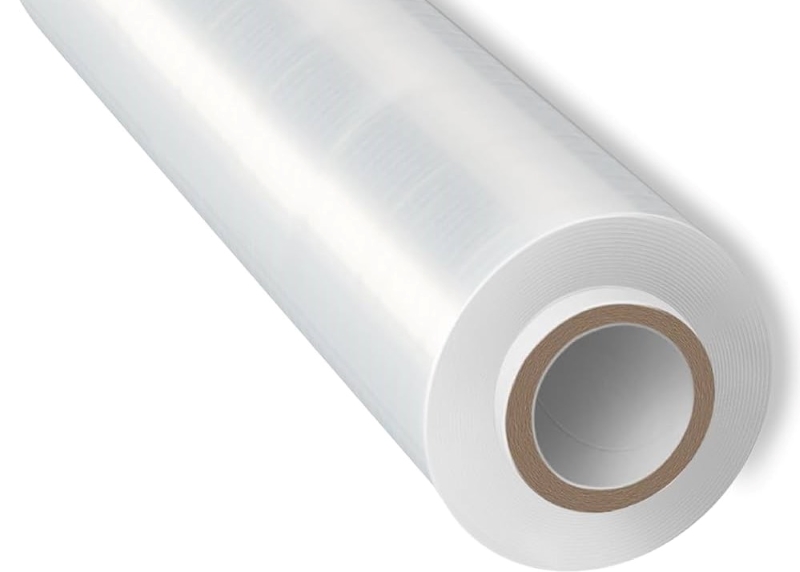
Wide stretch wrap is a type of plastic film used primarily for securing and protecting products during storage and transport. With its substantial width, wide stretch wrap is ideal for wrapping large items, pallets, and furniture, making it an essential tool in various industries, including logistics, manufacturing, and retail. Its elastic properties allow it to conform tightly around items, providing stability and preventing shifting during transit. Additionally, using wide stretch wrap enhances protection against dust, moisture, and damage, ensuring that products arrive at their destination in excellent condition. By incorporating wide stretch wrap into packaging operations, businesses can improve efficiency and reduce the risk of product loss, ultimately contributing to greater customer satisfaction. Wide stretch wrap is a plastic film, 18-80+ inches wide, used to secure, bundle, and protect items like furniture, boats, and products during transport.
Wide stretch wrap comes in a variety of sizes, catering to different packaging needs across various industries. The most common widths for wide web stretch film range from 20 inches to 80 inches, allowing users to select the appropriate size based on their specific applications.

When selecting the appropriate size of wide stretch wrap, consider the following factors:
By understanding these factors, businesses can effectively choose the right wide stretch wrap size to meet their specific packaging requirements and enhance operational efficiency.
Wide stretch wrap is an excellent solution for protecting furniture during moves or storage. Its elastic properties allow it to conform tightly around various shapes and sizes, providing a protective barrier against dust, dirt, and scratches. This is particularly important for delicate surfaces and upholstery, where traditional moving blankets may not provide adequate protection.
When moving furniture, wide stretch wrap offers several advantages:
To maximize the benefits of wide stretch wrap when securing furniture, consider the following tips:
By utilizing wide stretch wrap effectively, you can ensure that your furniture remains in excellent condition throughout the moving wrap process.
When considering the purchase of wide stretch wrap, understanding the cost implications is essential for effective budgeting and maximizing value. The cost of wide stretch wrap can vary based on several factors, including size, thickness, and the type of material used.
When evaluating the costs associated with wide stretch wrap, consider the following factors:
The following table provides a comparison of typical prices for different sizes and thicknesses of wide stretch wrap:
| Size (Width) | Thickness (Gauge) | Approximate Price per Roll |
|---|---|---|
| 20 inches | 60 gauge | $25 |
| 30 inches | 80 gauge | $30 |
| 40 inches | 80 gauge | $35 |
| 60 inches | 80 gauge | $45 |
| 80 inches | 100 gauge | $60 |
By understanding these cost considerations and comparing options, businesses can make informed decisions when purchasing wide stretch wrap, ensuring they select the right product for their specific needs while staying within budget.
Extra wide stretch wrap is designed to provide enhanced coverage and protection for a variety of applications. Its unique characteristics make it an ideal choice for businesses and individuals needing to secure large items or multiple products efficiently.

When considering extra wide stretch wrap, the following benefits are noteworthy:
Extra wide stretch wrap proves particularly advantageous in several scenarios, including:
The features and benefits of extra wide stretch wrap make it a valuable resource for anyone needing efficient and effective packaging solutions.
The 24-inch wide stretch wrap is a popular choice in the packaging industry, offering a balance of coverage and convenience. Its dimensions make it versatile for various applications, ensuring items are securely wrapped for transport or storage.
The 24-inch wide stretch wrap comes with several notable features and benefits:
The 24-inch wide stretch wrap is particularly advantageous in various scenarios, including:
The 24-inch wide stretch wrap is an effective solution for a range of packaging needs, combining practicality with superior performance.
Machine stretch film comes in a variety of widths to suit diverse packaging and protection needs. These widths range from narrow options for smaller or irregular loads to wide stretch wrap, which efficiently covers larger items. Choosing the correct width ensures not only cost savings but also improved efficiency during storage, transportation, and packaging operations. Below is a detailed breakdown of the common widths of machine stretch film and their specific applications:
Suitable for: Small to medium-sized pallets, boxes, and lightweight items.
This is the most common width for general packaging needs. It strikes a balance between manageability and coverage, making it versatile for a wide range of industries.
Suitable for: Medium to large loads, furniture, and appliances.
Wider than standard film, this width provides faster coverage of moderately large items, reducing the number of passes required and saving time and labor.
Suitable for: Oversized items like large pallets, couches, boats, machinery, and industrial equipment.
Wide stretch wrap is designed to cover broad surfaces efficiently, minimizing material usage and increasing productivity. It is particularly advantageous for large-scale applications, where full coverage and stability are required.
Wide stretch wrap, typically in the 60-80+ inch range, is ideal for businesses and movers handling bulky items. Its broader coverage reduces the need for multiple passes, making operations faster and more cost-effective. Unlike narrower wraps, which can be tedious for oversized items, wide stretch wrap delivers seamless protection and stability for heavy or irregular loads, enhancing efficiency during transport and storage.
By understanding these common widths and their applications, businesses can make informed decisions to improve packaging processes, reduce waste, and save costs.
Hand stretch film is a versatile packaging tool, available in various widths to meet the demands of manual wrapping applications. Whether bundling small items or securing large furniture, choosing the right width ensures efficiency, protection, and cost savings. Below is a detailed explanation of the most common widths of hand stretch film, including the advantages of wide stretch wrap for manual wrapping tasks.

Suitable for: Bundling small boxes, pipes, tools, or loose items.
Narrow hand stretch wrap is ideal for securing small or irregular-shaped loads. It is lightweight, easy to handle, and perfect for tasks that require precision and control.
Suitable for: Small to medium-sized packages, furniture edges, and general-purpose bundling.
This width strikes a balance between ease of use and coverage. It is widely used in warehouses and moving applications where flexibility and maneuverability are essential.
Suitable for: Large furniture, appliances, pallets, and bulky items.
Wide stretch wrap for hand application provides broader coverage, reducing the number of wraps needed to secure large items. It is ideal for protecting couches, tables, and heavy goods during storage and transport, saving time and effort.
Wide stretch wrap, typically 20-30 inches, is a game-changer for manual wrapping tasks that involve large, bulky items. Its broad width allows users to secure oversized loads quickly and efficiently without excessive material use. This is particularly beneficial during moving, shipping, and storage operations, where time and protection are crucial.
By understanding the common widths of hand stretch film and their specific uses, businesses and individuals can choose the right product to optimize wrapping tasks, ensuring security, stability, and cost-effectiveness.
When selecting stretch wrap for securing and protecting items, the width plays a crucial role in determining its efficiency and use. Wide stretch wrap stands out because of its ability to cover large areas quickly, while narrower wraps offer precision for smaller or irregularly shaped items. The choice between wide stretch wrap and other widths depends on factors such as application, coverage area, material usage, and ease of handling. Below is a table that highlights the key differentiating factors, providing insight into how each width serves specific purposes.
| Factor | Wide Stretch Wrap | Narrow Stretch Wrap | Impact on Use |
|---|---|---|---|
| Width Range | Typically 18" to 80"+ | Ranges from 5" to 18" | Wide wraps cover large surfaces; narrow wraps focus on precision. |
| Primary Application | Large furniture, boats, and pallets | Bundling small items, boxes, or parts | Wide wraps secure bulky items; narrow wraps bundle smaller loads. |
| Material Efficiency | Requires fewer passes over large items | Requires more material for large coverage | Wide wraps save time and material for big items. |
| Ease of Handling | Heavier and requires more effort to maneuver | Lightweight and easier to manage | Wide wraps are ideal for machines; narrow wraps suit manual tasks. |
| Cost | Higher initial cost per roll | Lower initial cost per roll | Wide wraps can be cost-efficient for large jobs; narrow wraps are economical for small tasks. |
This comparison helps users choose the right stretch wrap width based on their application, ensuring optimal efficiency and performance.
Stretch wrap is available in various widths, typically ranging from 12 inches to 40 inches. The most common widths are 15 inches, 18 inches, and 24 inches, with the latter being particularly popular for industrial applications. The choice of width depends on the items being wrapped; wider wraps are ideal for larger items or pallets, while narrower wraps are suitable for smaller products. It’s essential to select the appropriate width to ensure proper coverage and securing of the items, as this impacts both protection and ease of use.
The thickness of stretch wrap is often measured in gauges, with the thickest commonly found being 120 gauge. This high-gauge stretch wrap is designed for heavy-duty applications, providing exceptional strength and puncture resistance. It’s particularly useful for securing heavy items or loads that will be exposed to harsh conditions during transport or storage. When selecting stretch wrap thickness, consider the weight and nature of the items, as well as the storage and shipping conditions they will encounter.
80 gauge stretch wrap strikes a balance between flexibility and strength, making it suitable for a variety of applications. It offers good puncture resistance and cling properties, ensuring that items remain securely wrapped during transit. This thickness is often used for medium-weight loads and is commonly found in retail packaging, moving furniture, and securing pallets. While it may not be as robust as heavier gauges, 80 gauge stretch wrap provides adequate protection for everyday wrapping needs, making it a popular choice for businesses.
To wrap a couch using wide stretch wrap, start by cleaning the couch and removing cushions or detachable parts. Place these parts in separate bags or boxes. If the couch has delicate fabric, first cover it with a moving blanket for protection. Then, unroll the wide stretch wrap and tightly encircle the couch, starting at the base and working your way up. Make sure to overlap each layer for extra durability. Wide stretch wrap, typically 18-24 inches or larger, makes it easier to secure large sections of furniture quickly, minimizing effort and reducing waste. Pay close attention to the corners and arms, as these are high-impact areas. Use multiple passes with the stretch wrap to hold everything firmly in place. This method prevents scratches, dirt, and moisture damage while also keeping the couch components together during transportation.
The main difference between cast stretch wrap and blown stretch wrap lies in their manufacturing process and performance. Cast stretch wrap is made using a casting process that results in a clear, smooth, and quiet film. It unwinds silently and is ideal for wrapping large items like couches because of its ease of application and better transparency.
On the other hand, blown stretch wrap is made using air-cooled technology, resulting in a stronger, more puncture-resistant film. While it is noisier during unwinding and less transparent, it’s ideal for securing sharp or irregularly shaped loads.
For wide stretch wraps, cast wrap is often preferred for furniture moving due to its smooth texture and flexibility, while blown wrap might be better for rugged, industrial packing needs. Your choice depends on durability, clarity, and cost priorities.
Shrink wrap and stretch wrap are two distinct materials used for packaging. Shrink wrap requires heat to shrink and tightly conform to the object it covers. It is typically used for bundling products, securing pallets, or protecting items for long-term storage.
In contrast, stretch wrap does not require heat; instead, it stretches and adheres to itself when applied under tension. This makes it faster and safer for wrapping large or bulky items like furniture. Wide stretch wrap, often ranging from 18 to 60 inches, is excellent for quickly covering couches, appliances, and large surfaces during moving or storage.
For moving furniture, stretch wrap is preferred because it’s easy to apply, offers flexibility, and provides a secure barrier against dirt and moisture. Shrink wrap, while effective, isn’t as practical for on-the-go tasks without the heat-shrinking process.
Stretch wrap thickness is typically measured in mils (1 mil = 0.001 inches) or microns. Common thicknesses range from 30 to 120 gauge (7.5 to 30 microns). For household or furniture moving, stretch wrap around 60-80 gauge (15-20 microns) is most popular because it strikes the right balance between flexibility and durability.
Wide stretch wrap, used for covering large items like couches or appliances, often comes in thicker gauges to handle the increased tension and weight. Thicker wraps offer higher puncture resistance and better protection against damage, which is essential for heavy or sharp-cornered furniture.
If you need extra protection during moving, choose a higher gauge wrap (e.g., 80 gauge), as it provides more stability. However, for lighter loads or temporary coverage, thinner wraps are sufficient and easier to apply.
“Woven wraps” generally refer to woven plastic or textile wraps used for securing heavy loads or furniture. For stretch wraps specifically, wide varieties can range from 18 inches to 60 inches or more, depending on their intended use.
The most common width for wide stretch wrap is 18 to 24 inches, ideal for moving large furniture like couches, tables, and appliances. Some industrial versions can reach up to 60 inches, making them suitable for securing pallets or protecting oversized surfaces.
Wider wraps cover more area quickly, reducing the number of passes needed to secure large items, which saves time and material. This feature makes wide stretch wrap particularly useful for movers, as it streamlines the process of protecting furniture while keeping everything clean, compact, and safe during transport.

My name is James Thompson, and I’m the editor of this website dedicated to Stretch Film, Pallet Wrap, and Stretch Wrap products.
My passion for packaging began when I noticed the challenges companies face in securing their products efficiently for transportation and storage. This inspired me to delve deep into the world of stretch films and pallet wraps, exploring the latest technologies and best practices.
I aim to provide valuable insights, practical tips, and up-to-date industry trends to assist you in making informed decisions. Whether you’re a small business owner or part of a large corporation, my goal is to support you in optimizing your operations and ensuring your products reach their destination safely.
Thank you for visiting, and I look forward to accompanying you on your journey toward better packaging solutions.
Comments are closed